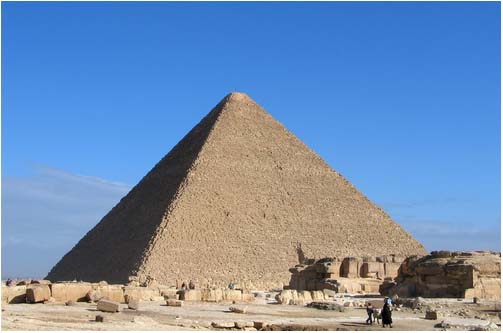Egyptian pyramid is full of shells
Many famous works of ancient Egypt, such as the Sphinx and Cheops pyramid, contained hundreds of thousands of sea fossils, most of them intact, lying dormant in the walls, a new study reveals.
Experts at Aegean University and the University of Athens analyzed mineralogy, as well as the structure and chemical composition of small samples of materials carved out of the Sphinx temple, Cheops pyramid, Khefren temple and temple. Osirion Shaft, Valley, Seti I temple in Abydos and Qasr el-Sagha in Fayum.
X-ray and radioactivity analysis showed that the original materials for construction were "pink" granite, black and white granite, sand stone and many types of limestone. In limestone blocks contain countless clam fossils of the genus nummulites . In Cheops pyramid alone, the rocks containing them account for 40% of all building blocks.
Experts also believe that because these fossils are mostly intact and randomly arranged in stone, if large blocks of stone used to build these giant structures must have been carved from natural stone, rather than casting like concrete.

Walls of ancient Egyptian buildings filled with shells.(Photo: planetware)
However, Joseph Davidovits, a professor and director at the Geopolymer Institute of France, thinks that he should consider carefully before making such a hypothesis. He and other experts were inclined to hypothesize that the blocks were cast in concrete style.
"There is no evidence that the ancient Egyptians had cranes. Without cranes, it was hard to imagine how they could lift giant stones, sometimes weighing up to 200 tons, up. High, "said Robert Temple, an expert on Egyptian monuments, supporting the view of Davidovits.
However, Temple also had to agree that "the limestone blocks of the Egyptian pyramid contained many shells, often in large numbers, and many of them were intact, with large sizes."
- 25 unexpected facts about the Egyptian pyramids
- Mystery of the American Pyramid
- Discovering the first pyramid of humanity, building 1000 years before the Egyptian Pyramid
- Unusual heat in the Egyptian pyramid
- Find 2 missing Egyptian pyramids
- Discovered a huge mysterious tunnel in the Egyptian pyramid
- Secret of the red pyramid in Egypt: After 141 years of decoding a part
- How was the Egyptian pyramid built?
- Pyramid: The most mysterious architecture of mankind
- The robot explores the pyramid
- Black coffins are hundreds of tons near the Egyptian pyramid
- Mysterious around the oldest pyramid in Egypt
 Discovered an ancient centipede fossil 99 million years old
Discovered an ancient centipede fossil 99 million years old Discovered bat-like dinosaurs in China
Discovered bat-like dinosaurs in China Discovered a 200-year-old bronze cannon of the coast
Discovered a 200-year-old bronze cannon of the coast Discover 305 million-year-old spider fossils
Discover 305 million-year-old spider fossils